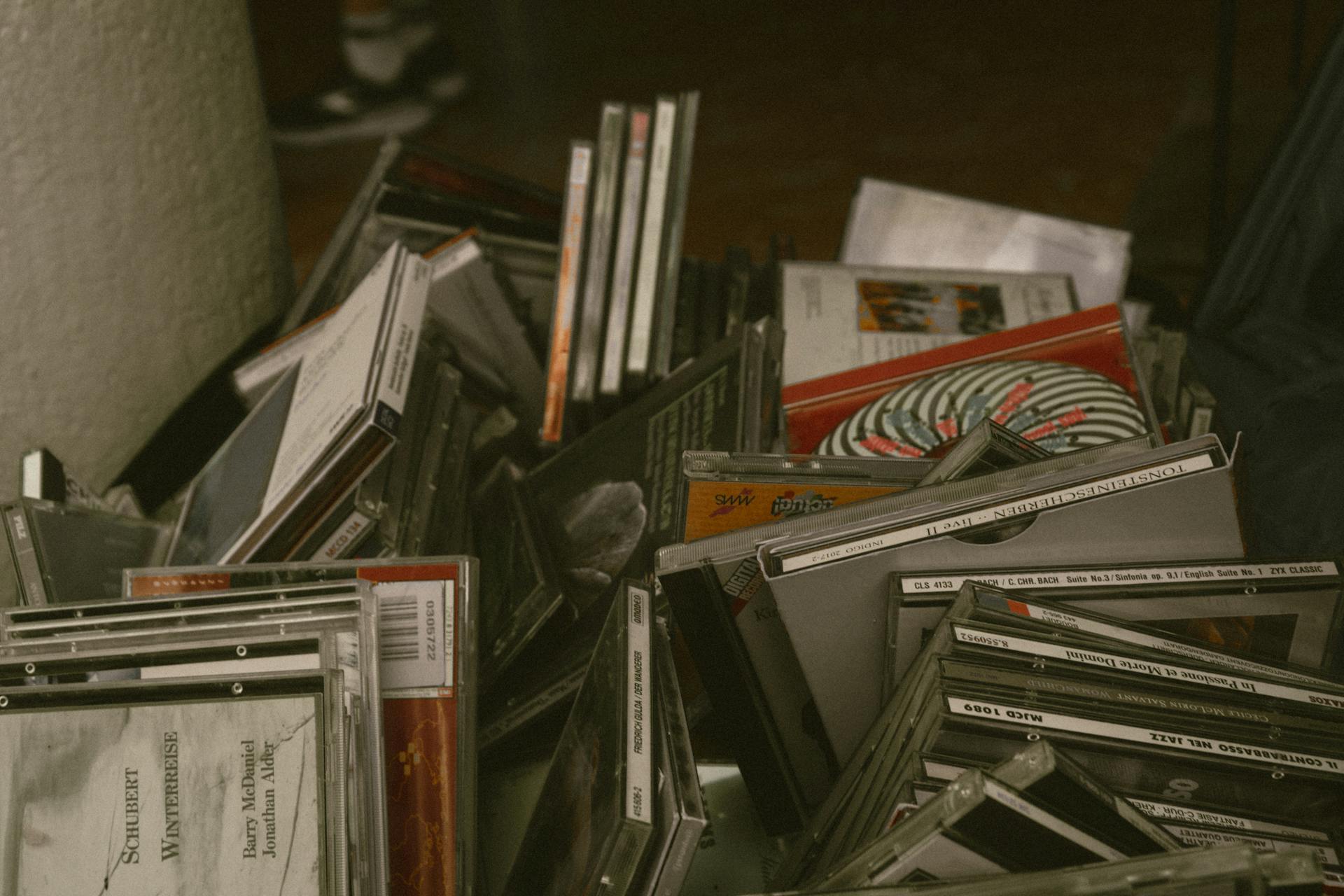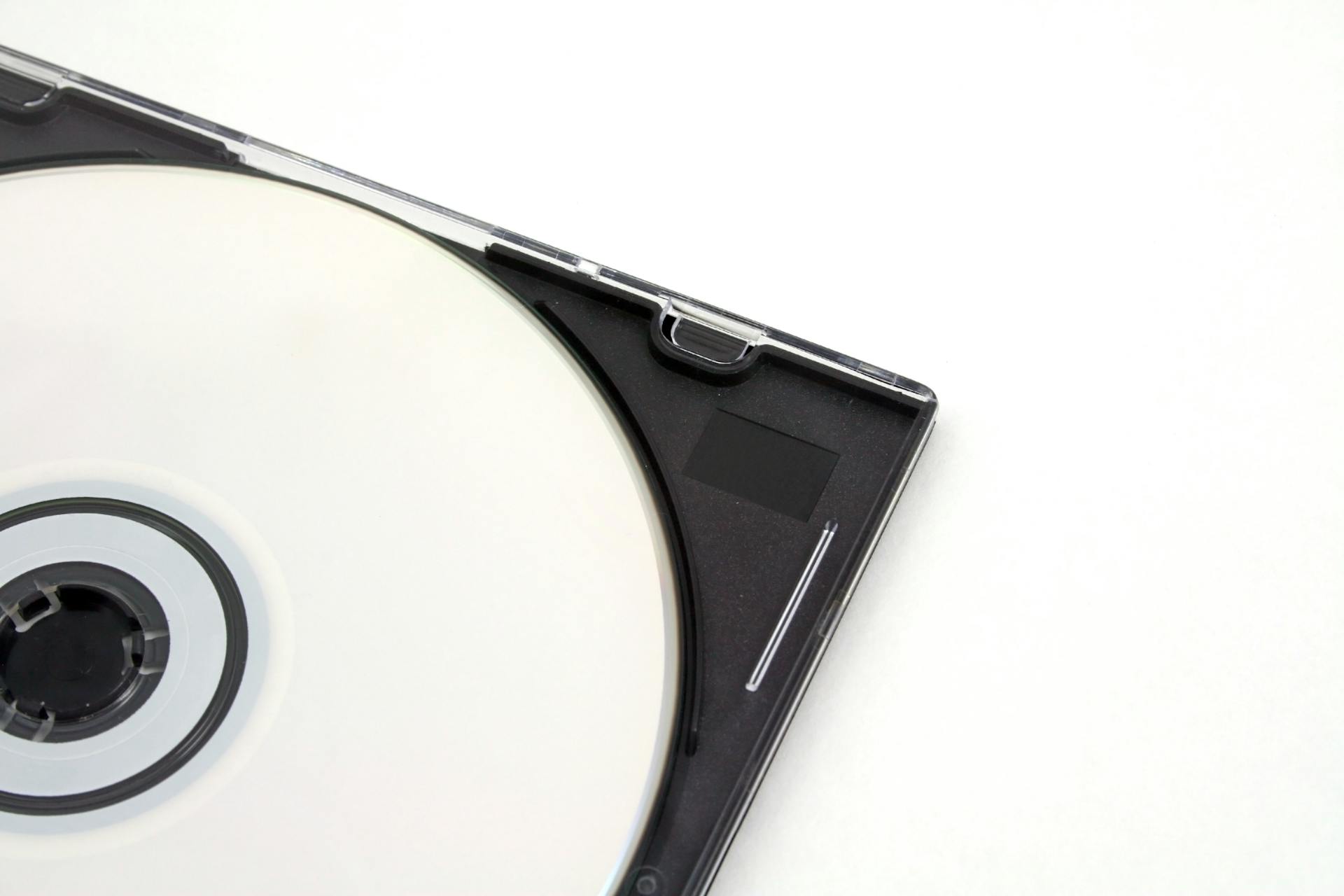
Choosing the right CD packaging size can make a big difference in how your music is perceived by potential buyers. The standard CD packaging size is 5.25 inches by 5.25 inches by 0.5 inches.
The cost of CD packaging can vary greatly depending on the size and material. A standard CD case can cost as little as $0.05 per unit.
A larger CD case, such as a 6 inch by 6 inch by 1 inch case, can cost upwards of $0.20 per unit. This is because more material is required to produce the larger case.
CD Packaging Sizes
CD packaging sizes can vary depending on the type of packaging and the number of discs included. The standard CD packaging sizes include jewel cases, digipaks, and CD wallets.
Jewel cases are a classic option, measuring 5.59 inches wide, 4.92 inches tall, and 0.39 inches deep. This provides ample space for the CD, booklet, and back insert.
Digipaks offer a more eco-friendly alternative and come in standard and DVD-sized options. The standard digipak measures 5.31 inches wide and 4.92 inches tall. The DVD-sized digipak measures 5.31 inches wide and 7.48 inches tall.
CD wallets are a compact and portable option, ideal for multi-disc collections or when space-saving is a priority. Single CD wallets measure 5 x 5 inches, double wallets measure 5 x 5 x 0.25 inches, and multi-disc wallets can hold up to 24 CDs.
Here are some common CD packaging sizes:
Gatefold CD jackets offer an elegant solution for showcasing artwork and including additional content. They typically measure 5.5 x 5 inches when closed and 11 x 5 inches when open.
Package Design Considerations
When designing a CD package, consider the overall aesthetic and how it will be perceived by the consumer. The CD package size should be chosen with the music's genre and target audience in mind.
A larger CD package size can accommodate more artwork and information about the artist, which can be beneficial for indie or niche artists. However, it may not be suitable for mainstream or commercial artists who require a more streamlined look.
For a more minimalist approach, consider using a smaller CD package size with a bold and eye-catching design.
Cost Implications
As you consider the various packaging options for your product, it's essential to think about the cost implications. Package size directly affects production and shipping costs.
A jewel case has a low production cost, which is a great advantage. The low shipping cost is also a bonus, as it will save you money on delivery.
The production cost of a digipak is medium, which is a good middle ground. The shipping cost is also medium, so you won't break the bank.
On the other hand, a box set has a high production cost and a high shipping cost. This is because it requires more materials and is heavier, making it more expensive to produce and ship.
Here's a comparison of the relative costs for different packaging sizes:
Gatefold Jackets
Gatefold jackets offer an elegant solution for showcasing artwork and including additional content. They typically measure 5.5 x 5 inches when closed and 11 x 5 inches when open.
Gatefold jackets provide ample space for liner notes, lyrics, and additional artwork, enhancing the overall user experience.
Gatefold jackets are a great choice for artists who want to include more content with their CD releases.
Album Cover Design
Designing your album cover is a crucial step in creating a professional-looking CD. It's essential to consider not only the aesthetic appeal, but also the practical aspects that affect the final print quality.
Understanding the bleed and safe area will ensure that your album cover artwork is both striking and professionally produced. Bleed refers to the area that will be trimmed off during the cutting phase, and it's vital to accommodate any slight variations.
The safe area is the 1/8 inch around the margin of your cover or inlay card, where you should keep all valuable text and logo information. This is because cutting may vary ever so slightly, and you want to play it safe near the borders.
To create a professional-looking CD cover, you can use software tools like Microsoft Word, Publisher, or PowerPoint, as well as graphic arts programs like Adobe Photoshop and Illustrator. Just use the simple diagram below to size your file and create any needed bleeds.
Here's a quick reference guide to CD cover size specifications:
By following these guidelines, you'll be able to create a stunning album cover that will make your CD stand out.
Package Types and Features
CD packaging sizes have become standardized, but each size has its unique features and capabilities. A Jewel Case can accommodate a booklet and tray card.
A Digipak, on the other hand, can fit an extended booklet and fold-out panels, making it ideal for artists who want to include more content. A Slim Case is best suited for a single-page insert.
Here's a comparison of the different package types and their features:
Shipping and Handling
Shipping and handling CD packages requires some care to ensure they arrive at their destination safely. Fragile items like jewel cases need to be padded properly to prevent damage during transit.
Jewel cases are particularly delicate, measuring 5.59 x 4.92 x 0.39 inches, so they need extra protection. This makes them a bit more expensive to ship.
A CD mailer, on the other hand, is designed for safe postal delivery, with dimensions of 6.00 x 6.00 x 0.25 inches. This makes it a great option for shipping CDs.
The dimensions of a digipak, 5.59 x 4.92 x 0.20 inches, are relatively small, making it a lightweight option that's less prone to cracking.
Here's a comparison of common CD packaging sizes and their shipping considerations:
Accommodating Special Features
Accommodating special features is crucial when designing different CD package sizes. You can include a booklet and tray card in a jewel case.
A jewel case can only accommodate a booklet and tray card. This is because of its compact size. I've seen some designers get creative with the booklet, but it's generally limited to a single sheet.

A digipak, on the other hand, can accommodate extended booklets and fold-out panels. This makes it a great option for artists with a lot of content to share.
If you need to include a single-page insert, a slim case is a good choice. This is because of its slim design that allows for a single sheet of paper.
A box set can accommodate multiple discs and collectibles. This makes it a great option for artists with a lot of music to share or for those who want to include special items with their CD.
Here's a comparison of the different package sizes and their special features:
Digipak Covers
Digipak covers are a type of CD case that consists of two parts: a plastic CD holder and a folding cardboard cover. This design makes digipak covers environmentally friendly due to fewer plastic details and safer for the environment paper.
The standard digipak CD album cover size is 5.492” x 4.941.” This size is crucial to ensure your design fits perfectly and doesn't get cut off during the printing process.
To create a digipak cover, you'll need to consider the bleed and safe area to ensure your design is both striking and professionally produced. Understanding these elements is vital in the printing process to accommodate any slight variations during the cutting phase.
A digipak cover typically has two parts: a plastic CD holder and a folding cardboard cover. The plastic CD holder is more durable than the cardboard, but the cardboard is more environmentally friendly.
Design and Printing
When designing for different CD package sizes, it's essential to consider the finished dimensions for the outside of printed CD covers, which are 4.724 inches square.
Many printed designs include a bleed area, which is an extra 1/8″ of space for design elements or backgrounds to extend beyond the finished size of your piece. This bleed area is then printed slightly oversized, at 4.974 inches square, before being cut down to size.
The inlay card, which creates the cover for the back and both spines, has finished dimensions that are not square to accommodate the folded part needed to make the spines.
Printing Specifications

When printing CD covers, it's essential to consider the finished dimensions. The outside of printed CD covers are 4.724 inches square.
For a professional look, many designs include a bleed area, which is an extra 1/8″ of space for design elements or backgrounds to extend beyond the finished size.
A CD cover with bleeds is printed slightly oversized (4.974 inches square) to achieve this effect.
The inlay card, on the other hand, has a non-square shape to accommodate the folded part needed to make the spines on each end.
The inlay card creates the cover for the back and both spines, while the CD Cover inserts into the lid of the CD case.
Bleed and Safe Area Explained
The finished dimensions for a printed CD cover are 4.724 inches square, but many designs include bleed, which is an extra 1/8″ of space for design elements or backgrounds to extend beyond the finished size.
To accommodate bleed, the printed CD cover is printed slightly oversized (4.974 inches square) and then cut down to size, giving the appearance that the printing "bleeds" off the edge of the cover.
A safe zone is recommended to keep valuable text and logo information away from the cut line. This zone is the 1/8 inch around the margin of your cover or inlay card.
To ensure your design is protected, it's essential to understand the concept of bleed and safe area. Bleed refers to the extension of any color, photo, or design elements past the cut line, while safety margin is the opposite of bleed, represented by green lines on the Disc Makers templates.
To determine the size of a CD album cover, keep your important text and images at least 1/8” inside the safety margin to avoid anything being cut off. This is a crucial concept to understand when working with custom printing.
Here's a quick summary of the key facts to keep in mind:
Digipak Details
Digipaks offer a more eco-friendly alternative to traditional CD packaging.
The standard digipak CD album cover size is 5.492” x 4.941”, which is also the size for the front and back of the digipak.
Digipaks can vary in thickness depending on the number of panels and discs included.
The standard digipak size has two parts: a plastic CD holder and a folding cardboard cover.
The key benefit of digipak is its environmental friendliness due to fewer plastic details and safer for environment paper.
Here are the standard digipak sizes:
Unfortunately, digipaks have not gained popularity due to low durability and weaker protection of disks.
Phone Accessories
The standard jacket CD album cover size is 5.063” x 4.968.”
Jackets with a tuck flap are 5.125” x 4.9375” with a back cover of 5” x 4.875.”
Phone cases can be designed to fit these exact dimensions, making it easy to create a cohesive look.
Jackets with a glue strip are 5.125” x 5.125” on the front cover and 5” x 5.125” on the back cover.
You can also use these measurements to create custom phone accessories like pop sockets or phone grips.
The 4 panel eco-wallet front and back covers are 5.5” x 5.”
Frequently Asked Questions
What are the dimensions of the CD package?
The CD package measures 5.59" x 4.92" x 0.39" (142 mm x 125 mm x 10 mm) in size. Perfect for storing your CDs safely and securely.
Sources
- https://packagingideas.co.uk/cd-packaging-sizes/
- https://www.printingforless.com/resources/cd-cover-size-specifications/
- https://www.ronyasoft.com/products/cd-dvd-label-maker/articles/cd_cover_dimensions/
- https://blog.discmakers.com/2024/07/cd-album-cover-size/
- https://www.printingblue.com/custom-cd-jackets.asp
Featured Images: pexels.com

